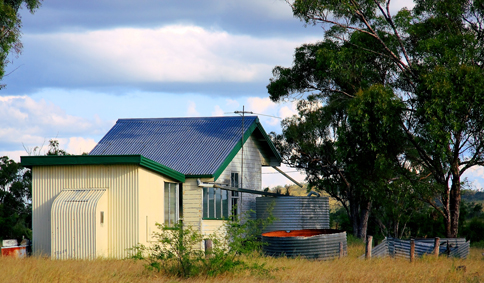Before reliable water supply systems were in place, water tanks used to be a common feature in all homes in Australia. Climate change and droughts have now caused us to reconsider rainwater as a valuable water resource.
Rainwater harvesting is also a great way of lowering your water bills, reducing your ecological footprint, and preserving some water for non-essential purposes – even during water restrictions.
There are standards in place to ensure the quality of rainwater that is collected by any rainwater harvesting system. In many areas, new buildings are expected to be ‘rainwater ready’ and homeowners are often given incentives for rainwater tank installation.
Here are some things you should know, as a homeowner, before planning a rainwater harvesting system in your home:
Regulations
Individual councils within Sydney have specific regulations to maintain the safety and quality of the water.
- Check with your local council about any safety regulations that limit the maximum possible size of the tank, its location or sometimes, even the colour.
- Usually, tanks with a capacity of 10,000L or less do not require special permits or approval, even though there are regulations to follow. Larger tanks do need special approval from the local council.
- NSW Health and Sydney Water do not recommend the use of rainwater for drinking or cooking. This is because the mains water supply undergoes thorough filtration and disinfection to maintain its quality while rainwater does not undergo any such process.
- There should be proper measures in place to ensure that the mains water supply is not affected by the quality of the water in the tank.
- Installation of a flow rate restrictor is also required to prevent your neighbours’ water pressure from being affected.

Uses of Rainwater
Rainwater can be used for all non-drinking purposes like flushing toilets, doing laundry, for gardens and landscaping, filling swimming pools, and washing cars.
Generally, 1 litre of water is collected from 1mm of rain that falls on 1m² area in your roof. This means that even a roof with an area of 100m² can collect 100 litres of water, from just 1mm of rain. The fact that Sydney gets an average rainfall of 1217mm annually should be enough to illustrate the significance of rainwater harvesting.
Size and Type of the Tank
To choose the right tank size, first decide for what purposes you will be using the water, the size of your roof, how much water your household consumes, and of course the average rainfall in your area. These factors will help you estimate the size of the tank required.
There are different types of water tanks available for different purposes:
- Polyethylene tanks: These are lightweight, durable options that are available in different colours and sizes. They can be used both above and below ground, depending on your needs.
- Concrete tanks: These durable tanks are usually built on site (above or below ground) and work best to prevent growth of algae and to keep water cool.
- Metal tanks: Made of corrugated metal or coated steel, these custom-made options are easy to transport.
- Fibre glass tanks: These tanks are a good above-ground option as they are rust and corrosion proof, and can withstand high temperatures.
- Bladder tanks: While these don’t really fit into our ideas of tanks, these are ideal for verandas or under house applications.
Before choosing any tank, make sure that they comply with Australian regulations and provide the relevant warranties.
Position and Installation
When choosing a position for your tank, other than the obvious building regulations and space restrictions, consider:
- That a location too near the retaining walls will add stress to the walls.
- That the tank can block sunlight, view or ventilation for you or your neighbours.
- That if a pump is to be used, you will need a location that minimises the noise.
- That you want regular access to the tank for any maintenance purposes.
For hygiene purposes, a minimum water level must be maintained if you plan to use the water for toilets or laundry. A good ‘top up’ system connected to the mains and properly fitted backflow prevention device are necessary to ensure this.
You will also need screens and gutter guards to prevent debris and insects from entering the tank. To reduce the accumulation of sediments and debris in the tank, a ‘first flush’ system is also recommended.
Regular maintenance is also essential to maintain the quality of the water.
- Regularly clean your roof and keep it free of tree leaves and other debris.
- Keep all overhanging branches regularly trimmed.
- Check the gutter guards, screens and other fittings regularly to ensure proper working.
- Once in two years, check the sludge level in the tank.
JEDI Plumbing is experienced in the installation of tanks of all types and sizes. Whether you need a small tank just to water your plants, or a large one to connect your toilets and washing machines, we can guide you in choosing the best possible option.
Call us on 0411 774 381 for all plumbing jobs in Sydney’s North Shore and Northern Beaches, including water tank installation.

